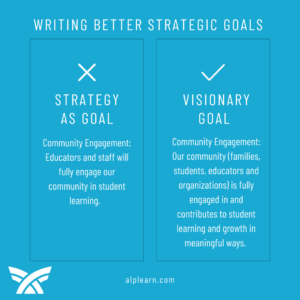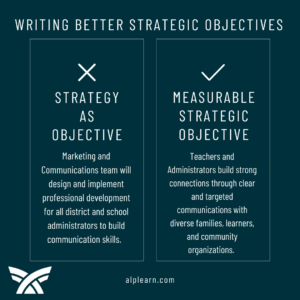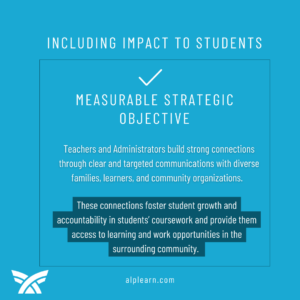When our Advanced Learning Partnerships (ALP) team partners with a district in the design of their strategic plan, we often begin with the question, “As an educator, what’s your starting point for lesson planning?” In response to which we hear variations of the following three replies:
- Start with the end in mind and work backwards.
- Start with learning outcomes.
- Start with what students should know and be able to do.
We nod and follow-up with a “What’s next?”, often receiving a variation on one of the 3 following answers:
- Identify the best way to scaffold learning toward the end goal.
- Define the lesson, instruction, and activities that get students to those learning outcomes.
- Put myself in the student’s perspective and design experiences to achieve learning goals.
By invoking the Understand by Design (UBD) process for curriculum development, specifically, identifying the outcome first and working backwards from there, we draw an important connection to the processes for strategic plan design and implementation. In this progression from visionary goals to the nuts-and-bolts tactics, districts often miss the critical step of identifying measurable outcomes that need to be achieved to reach higher level goals.
Over the past several years, Advanced Learning Partnerships (ALP) has collaborated with many districts on the design and implementation of their strategic plans. Our entry point in the planning process varies by district. Some teams are at the outset of identifying the plan’s major goals that will set the vision for what they hope to accomplish by the time the plan is finalized (typically in 4-5 years). Other districts have defined their goals and are already delving into the strategy for how they will achieve them.
Most often we are approached by districts who need consultation when they want to build key performance indicators (KPIs) and document their teams’ progress toward their vision. It is at this stage that educational leaders feel stuck and in need of guidance. ALP’s Organizational Systems team, composed of organizational psychologists and educational leaders, begins by analyzing the existing plan and most often uncovers one or more of the following pitfalls.
Pitfall #1: No North Star
While educational leaders possess significant talent and expertise when designing comprehensive instruction and curriculum, they sometimes do not make the connection between learning outcomes and lessons to a strategic plan’s objectives and strategy. One reason why districts feel lost at this point is that they have jumped to the lesson (“the how” or the strategy) before identifying the learning outcomes (the objectives, the outcomes, and the change that will occur once we reach our goals).
Educators tend to orient toward service to others (colleagues, students, and families) which could explain why in strategic planning, educators will start with the question, “What do I/does our team/does our department need to do to help our students?” This question is important, yet it often distracts from first asking the questions: “do what?” and “for what?” These questions focus leaders’ goals and objectives before diving into the strategies (or actions) needed to accomplish defined outcomes.
ALP consultants facilitate discussions that help strategic planners put themselves in the future they want to see in their organization. For this phase of planning, we find the following questions helpful:
- “What or who will change once you have successfully implemented your strategy?”
- “What will stakeholders be able to know, do, and/or feel once you have achieved your objective?”
We’ve named this pitfall “No North Star” because when teams start with the “how,” it’s hard to understand where the district is trying to go. Goals and objectives provide a shining light to illuminate the right path and clarify the desired destination.
Pitfall #2: Lack of Common Language
A precursor to the “No North Star” pitfall is a lack of common language for strategic planning. Strategic Planning is not a new process. For decades, organizational leaders have used various approaches to setting and achieving significant collective goals. We use the language of strategic planning–goals, objectives–in our everyday lives. Unfortunately, that daily use can muddle our shared clarity in using these terms. Connotations and definitions of words within the strategic planning lexicon (i.e., goal, objective, strategy, and tactics) vary greatly. Let me share an example.
Some community-facing strategic plans, may have a “goal” that looks similar to the following:
Goal: Our district educators and staff will fully engage our community in student learning.
This goal may have a supporting “objective” that looks similar to the following:
Objective: District Marketing and Communications team will design and implement professional development for all district and school administrators to build their communication skills.
At surface level, this may seem like clear planning toward enhancing staff and educator capacity around communications and engagement; however, both this “Goal” and this “Objective” are actually strategy, the “how” or the approach to achieve an objective or goal. These statements are strategy because they identify the actions of certain stakeholders (e.g., engage community, design and implement professional development, etc.).
To identify the outcome of strategies, we must first speak the same language. In this case, ALP consultants first offer clear definitions of “Goal” and “Objective.”
Goal: Broad and visionary statement of what the organization hopes to achieve over the course of the entire strategic plan.
Objective: Measurable outcomes or milestones that must occur to achieve the goal.
Next, we ask the questions listed in our “No North Star” pitfall. Here’s how those questions could provide clarifying responses to improve our previous strategy-as-goal statement:
“Goal 1”: Community Engagement – Our district educators and staff will fully engage our community in student learning.
- What will “our community” be able to know and do once they are fully engaged in student learning?
- They will be able to contribute to student learning in meaningful ways.
- Families will support their students to stay on track with their coursework.
- Students will have access to community resources to advance their learning, engage in authentic work experiences, and build communication skills.
- Community organizations will know about district events and opportunities to engage students in applied work study and internships.
- Educators will use targeted and concise communication modes to reach the right community audience at the right time.
Once we’ve generated some clarity for the original strategy (that was labeled as a “Goal”), we work to craft a true Goal statement:
Goal 1(revised): Community Engagement – Our community (families, students, educators, and community organizations) is fully engaged in and contributes to student learning and growth in meaningful ways.
Notice we’ve shifted to identify a broad and visionary statement of what the community is able to know and do as a result of the strategy that district educators and staff implemented. We have also identified more outcomes of the strategy for various stakeholders (more on that in the third pitfall). Finally, we have some measurable outcomes we can use in our objectives as we tackle this next question:
- What do we mean by “fully engage”? What does that look like/sound like/feel like for teachers, administrators, and families?
Objective 1.1 (revised) – Teacher and Administrator Communications: Teachers and Administrators build strong connections through clear and targeted communications with diverse families, learners, and community organizations. These connections foster student growth and accountability in students’ coursework and provide them access to learning and work opportunities in the surrounding community.
Objective 1.2 – Family Engagement: Families will access clear and timely communications about their students’ learning progress and targeted resources that support each child’s unique learning needs and interests. Family participation will increase in school and district community events and meetings.
Now that we’ve gained some clarity in outcomes and milestones that need to occur for the district community to demonstrate progress toward the Community Engagement goal, it’s important to ensure that all stakeholders are represented. This brings us to Pitfall #3: Lack of Stakeholder Representation.
Pitfall #3: Lack of Stakeholder Representation
Some organizations and teams get strategic planning language correct from the start. Their goals are high-level, inspiring, and visionary. Each goal’s supporting objectives define a clearer picture of measurable outcomes. These outcomes need to be achieved to realize the larger goal. Each objective then lists a specific strategy/strategies to move them toward outcomes identified. While all these plan components may be correctly defined, sometimes that defined change and outcomes leave out key stakeholders.
Let’s revisit the revised goal and objectives from Pitfalls 1 and 2:
Goal 1: Community Engagement – Our community (families, students, educators, and community organizations) is fully engaged in and contributes to student learning and growth in meaningful ways.
Objective 1.1 – Teacher and Administrator Communications: Teachers and Administrators build strong connections through clear and targeted communications with diverse families, learners, and community organizations.
Objective 1.2 – Family Engagement: Families will access clear and timely communications about their students’ learning progress and targeted resources that support each child’s unique learning needs and interests. Family participation will increase in school and district community events and meetings.
Here we see objectives and outcomes clearly identified; however, they describe what “Change Leaders” (those leading implementation of the strategy) will be “able to know and do” as an outcome. While this is important information, it is also incomplete. When we leave out changes to other types of stakeholders, we don’t have a clear picture of what are often the most important outcomes we hope to accomplish. Interestingly, stakeholders we call the “ultimate beneficiary” of the change, or those on the receiving end of the strategy (often students), lack clearly defined or measurable outcomes.
In this case, we would want to continue to generate ideas about what will change for students once teachers, administrators (Objective 1.1) and families (Objective 1.2) outcomes have been achieved. This includes some key additions (highlighted text) to existing objectives .
Objective 1.1 – Teacher and Administrator Communications: Teachers and Administrators build strong connections through clear and targeted communications with diverse families, learners, and community organizations. These connections foster student growth and accountability in students’ coursework and provide them access to learning and work opportunities in the surrounding community.
Objective 1.2 – Family Engagement: Families will access clear and timely communications about their students’ learning progress and targeted resources that support each child’s unique learning needs and interests. Family participation will increase in school and district community events and meetings. Students feel a sense of belonging in their school community and demonstrate increased attendance.
When a Plan Comes Together
Over the years, ALP team members have had the honor of working with many caring and committed education leaders in strategic plan design and implementation. Our process for organizing and facilitating this complex and rewarding work, allows educators to lean in and contribute their specialized training, leadership, informed perspectives, and talents to the plan without becoming lost in the language.
The importance of strong district leadership during this process cannot be overstated. This was clearly demonstrated in our recent strategic planning work with Superintendent, Frank Narducci and Associate Superintendent, Dr. Wendy Nance of Chandler Unified School District (AZ) and Superintendent, Dr. Monica Merritt and Chief Academic Officer, Bethany Rayl of Plymouth-Canton Community Schools (MI). These leaders empowered their cabinet members, school boards, district staff, and communities to contribute their voices and engage in the design and implementation plans for multi-year strategy.
Dr. Merritt reflects “Our strategic planning journey, guided by ALP’s expertise, has been an invaluable process, aligning our district’s vision with actionable goals and measurable objectives. It reflects a powerful blend of leadership, stakeholder involvement, and innovative approaches that’s shaping the educational landscape in our district for years to come.”
Because these executive leaders emphasized collaborative design and planning, they effectively
- leveraged the strengths and talents of their teams
- fostered ownership of the plan
- identified a clear path toward an inspiring vision for their communities of learners.
Concise, precise, and measurable outcomes create the North Star from which we design a comprehensive and viable plan. The strategic plan becomes the map for the design and implementation of actionable strategy, projects, and tactics. As Superintendent Frank Narducci emphasized: “All our work, everything, goes through the plan.”
Careful and clear planning is critical, especially when working at the educational systems or district-level. School districts are unique as they are what organizational research terms as “networked organizations” or multiple discrete organizations within one larger organization. In addition to plan design, ALP consultants collaborate with our educational partners to implement project management structures, systems, and professional learning for implementation leaders to see the plan through and arrive at their North Star.




